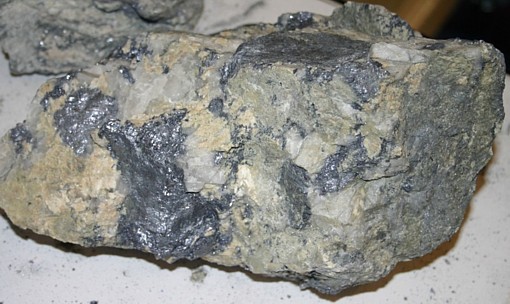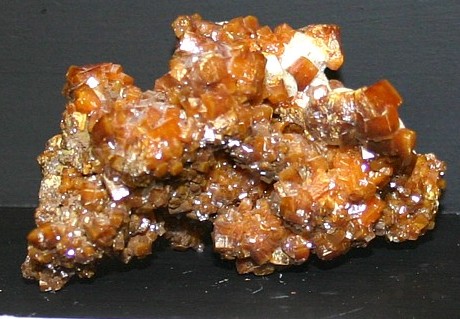Molybdenum is a rare
element occurring chiefly as the sulphide,
molybdenite. More rarely
wulfenite or powellite may serve as an ore. Molybdenum does
not occur in a free state in nature, but may be prepared from its sulfide (molybdenite)
direct in the electric furnace, or by the reduction of its oxide by means of
carbon, or by the Thermite process. The metal has a specific gravity of
about 9, melts at about 2,000 C., and is white or greyish, and brittle.
Molybdic acid (MoO3) is sometimes met with as the mineral molybdine or
molybdic ochre, and results from the surface alteration of other molybdenum
minerals. Molybdic acid forms salts known as molybdates; wulfenite is lead
molybdate, PbMoO4 . Molybdic acid is employed only in the laboratory.
Ammonium molybdate is a special reagent for the detection of phosphoric
acid, a small quantity added to an acid solution containing phosphates
producing after some time a yellow precipitate; also used in making
explosives. The principal use of molybdenum is in the manufacture of special
steels, and for this purpose ferromolybdenum alloy is frequently used in
place of the metal.
Molybdenum is used principally as a steel-hardening metal for special
alloys. It has found application both in armor plating and as a substitute
for tungsten in high speed steels. In the form of ammonium molybdate it is
used as a chemical reagent, as a fireproofing material, and as a
disinfectant. Molybdenum disulfide is used as an additive to grease, as a
solid lubricant and a high-pressure high-temperature (HPHT) anti-wear agent.
Molybdenum compounds are also used to color leather and rubber.
Molybdenum is sometimes mined as a principal ore, but it is also recovered
as a byproduct of both
copper ore and tungsten mining. Some mines in Colorado
including the Henderson mine and the inactive Climax mine as well as the
Hall mine near Tonopah, Nevada and the Endako mine in British Columbia yield
molybdenite as their primary product. On the other hand, many porphyry
copper deposits such as the Bingham Canyon Mine in Utah and the Chuquicamata
mine in northern Chile produce molybdenum as a byproduct of mining copper
ores. Most of the large Moilybdenum mines, be they worked for molybdenite
either as a primary or secondary mineral are formed from porphyry type
deposits.
The well known minerals of molybdenum are Molybdenite, Powellite and Wulfenite. However, the disulfide, Molybdenite, is the only source of any commercial importance. A yellowish oxidation product, molybdic ocher is formed on outcrops as an alteration product of molybdenite. Primary molybdenite ores can be readily concentrated by a combination of table-dressing and oil-flotation. It is a widely distributed ore, but frequently occurs in small veins, or very finely scattered through the rock in porphyry type deposits. It can be separated from the copper sulfides that commonly accompany it by differential flotation. Molybdenite concentrates are usually sold at so much per unit on a basis of 90 to 95 per cent. MoS2, but sales of lower grades can be made. The world's production of molybdenite is large and demand is increasing because of the need for high strength steel. Its chief sources are the US, China, Chile, Canada and Peru. It has also been mined in Australia, notably in Queensland.
The ores of this specialty metal occur in a number of different geologic environments. In the US, most molybdenum ore is associated with porphyry deposits, while in other worldwide locations, the ore is associated with tungsten ores. It is recovered from its ores by the process of flotation.
Tests. When heated on charcoal, molybdenum bearing compounds give in the oxidizing flame a white encrustation, which becomes blue where touched by the reducing flame. Molybdenum compounds color the microcosmic bead yellow when hot, colorless when cold, in the oxidizing flame; the borax test bead is green in the reducing flame.
UNITED STATES. A
rich deposit of molybdenite has been found on Bartlett Mountain and worked
near Climax near the Summit County border, Colorado, where it occurs in a
matrix of
quartz associated with
pyrite in a great body of porphyry rock containing
disseminated molybdenite. The Henderson mine is associated with this same
location and both are porphyry deposits. These deposits have been major
world producers, producing over a billion pounds of molybdenum each. The
Hall Molybdenum deposit near Tonopah is also a porphyry deposit that was
mined primarily for its moly content. An interesting occurrence of
molybdenum ore in the United States is that of the Mammoth Mine, in Arizona,
where wulfenite occurs in association with auriferous copper ore and
constitutes from 1 to 3 per cent, of the crude ore. Considerable wulfenite
has been obtained from the tailings of
gold ore of Pinal County, Arizona. It has also been found at
the O K mine in Utah. Small amounts of molybdenum ore have been found at
many other places in the western part of the United States. At Catherine
Hill, in the State of Maine, molybdenite is found in
granite and constitutes about 1-5 per cent, of the rock in
certain places. At Cooper, Washington County also in Maine, molybdenite
occurs in veins of
pegmatite traversing granites.
AUSTRALIA. Important deposits of molybdenite have been mined at Wolfram
Camp in the Chillagoe district of Queensland. The deposits consist partly of
quartz veins in granite and partly of contact deposits along the margin of
an intrusion of granite in slate. The molybdenite is associated with
wolframite and bismuth. In New South Wales the ore-bodies
assume the shape of quartz pipes traversing granite, and here again bismuth
and wolframite are frequently associated with the molybdenite. The ore has
been mined chiefly at Whipstick mine near Pambula, Kingsgate mine near Glen
Innes, and near Deepwater. The pipes vary from ten to fifty feet in diameter
and contain large -masses of ore. In some parts of New South Wales
molybdenite is associated with
cassiterite.
CANADA. Molybdenite occurrences have been actively investigated and
mined in various parts of Canada, chiefly at Quyon in Quebec, Lost Creek in
British Columbia, and various localities in Ontario, notably near Aldfield
and near Renfrew. The molybdenite is found in quartz veins and pegmatites
connected with granite intrusions; it is frequently associated with pyrites,
pyrrhotite and sometimes biotite.
NORWAY AND SWEDEN. At Knaben near Flekkefjord and various other
localities in southern Norway, molybdenite occurs in veins of massive quartz
and also in hornblende-granites, commonly associated with
chalcopyrite and mica. In nearly all these occurrences
granite or
gneiss is the country rock, but in some localities the
molybdenite is found in quartz veins traversing slates. In Sweden,
molybdenite is found associated with chalcopyrite in pegmatite veins that
cut across gneiss and
schist. Veins of this type having a thickness of several feet
have been worked on the island of Ekholmen to the north of Westervik in
south-east Sweden. JAPAN. Molybdenite is found at various localities
in the provinces of Hida, Bizen, Idzumo, and Yechigo, usually in quartz
veins, and invariably associated with granitic intrusions. In some places,
as at Shirakawa in Hida, large masses of molybdenite are found in decomposed
rock and can be easily extracted.
SPAIN. Molybdenite is known to occur at many localities in Spain, but of
Spanish deposits of molybdenum ore perhaps the most interesting are those of
wulfenite in the province of Granada. The best known deposits are those of
the Sierra Nevada about 12 miles from Granada, where wulfenite occurs
associated with
galena in Triassic
limestone.
Return
to Metal Ores Page:
Precious and Base Metal Ores

Above: Silver Molybdenite, the sulfide of Molybdenum, and also the only commercially important molybdenum ore.

Above: Typical rich molybdenite ore from Nevada.

Above: Wulfenite, a minor ore mineral of molybdenum.
